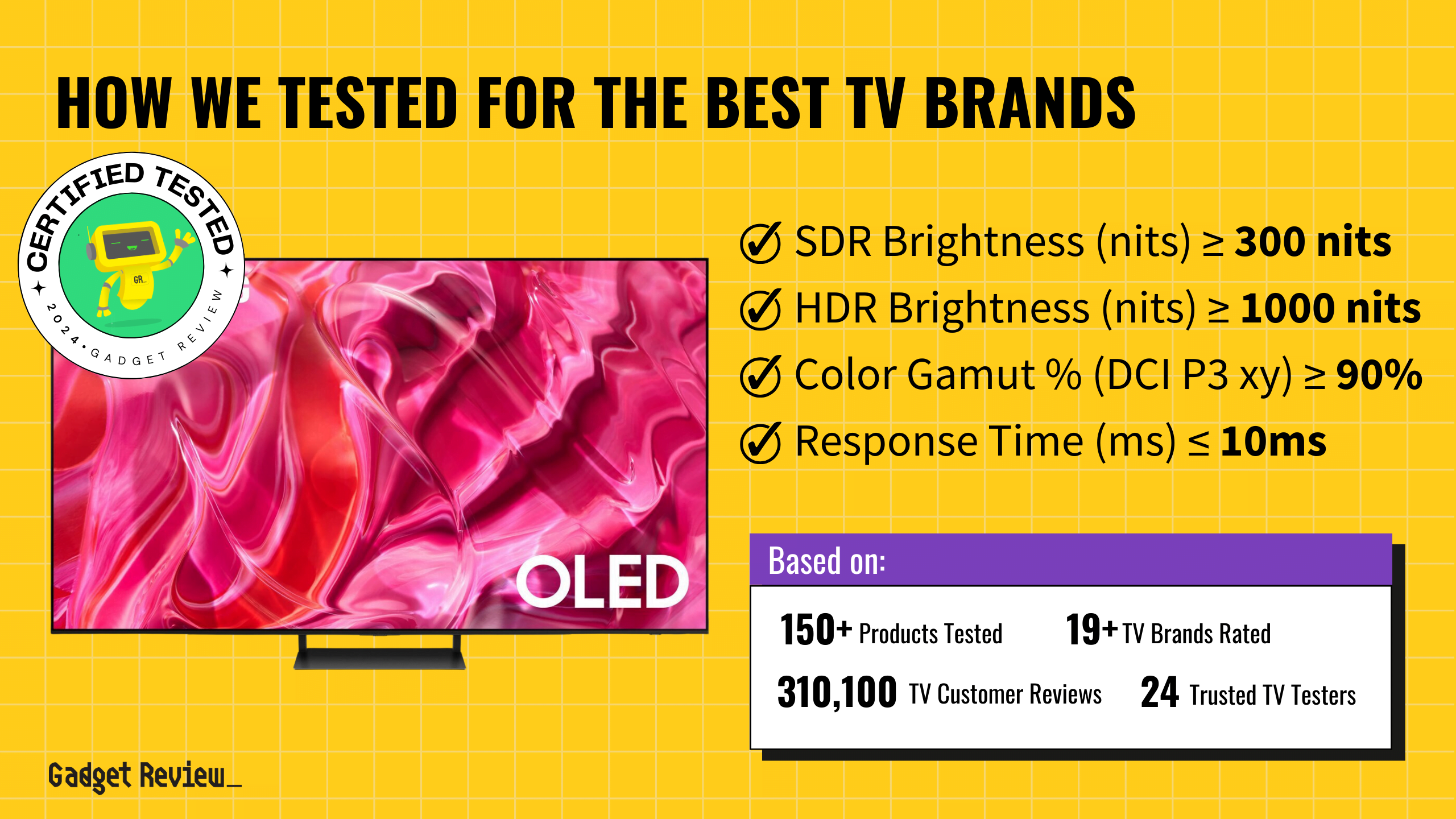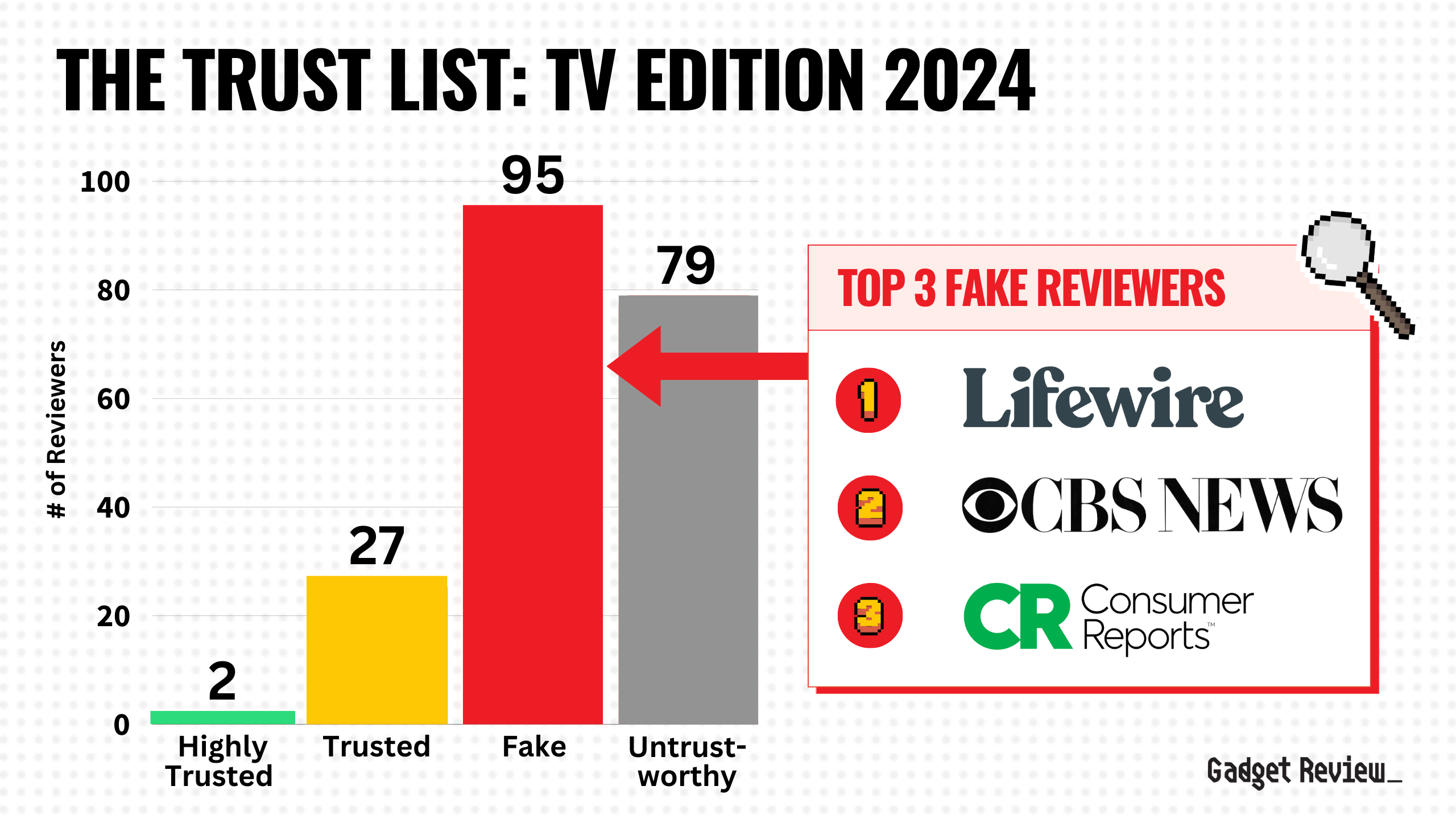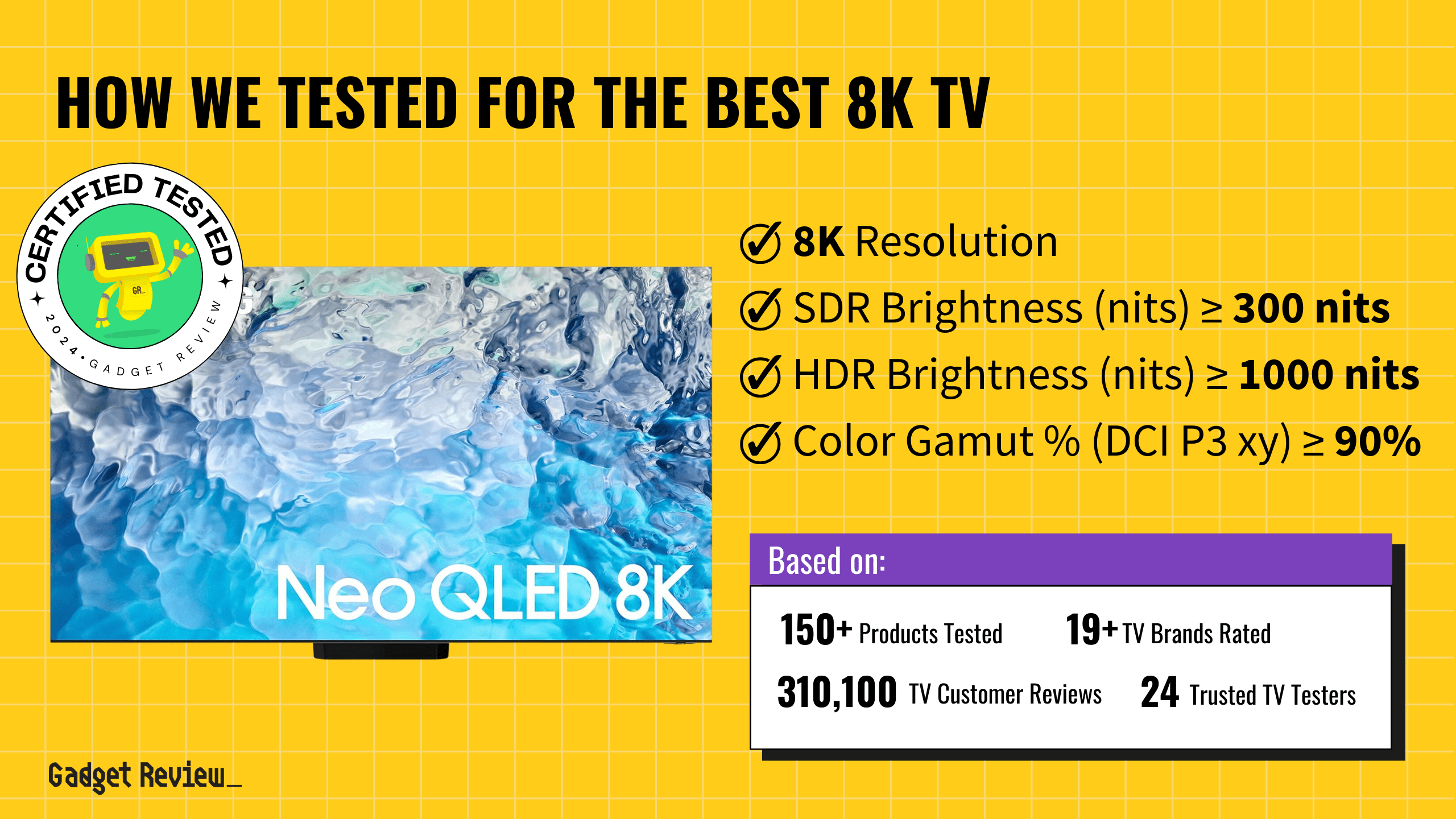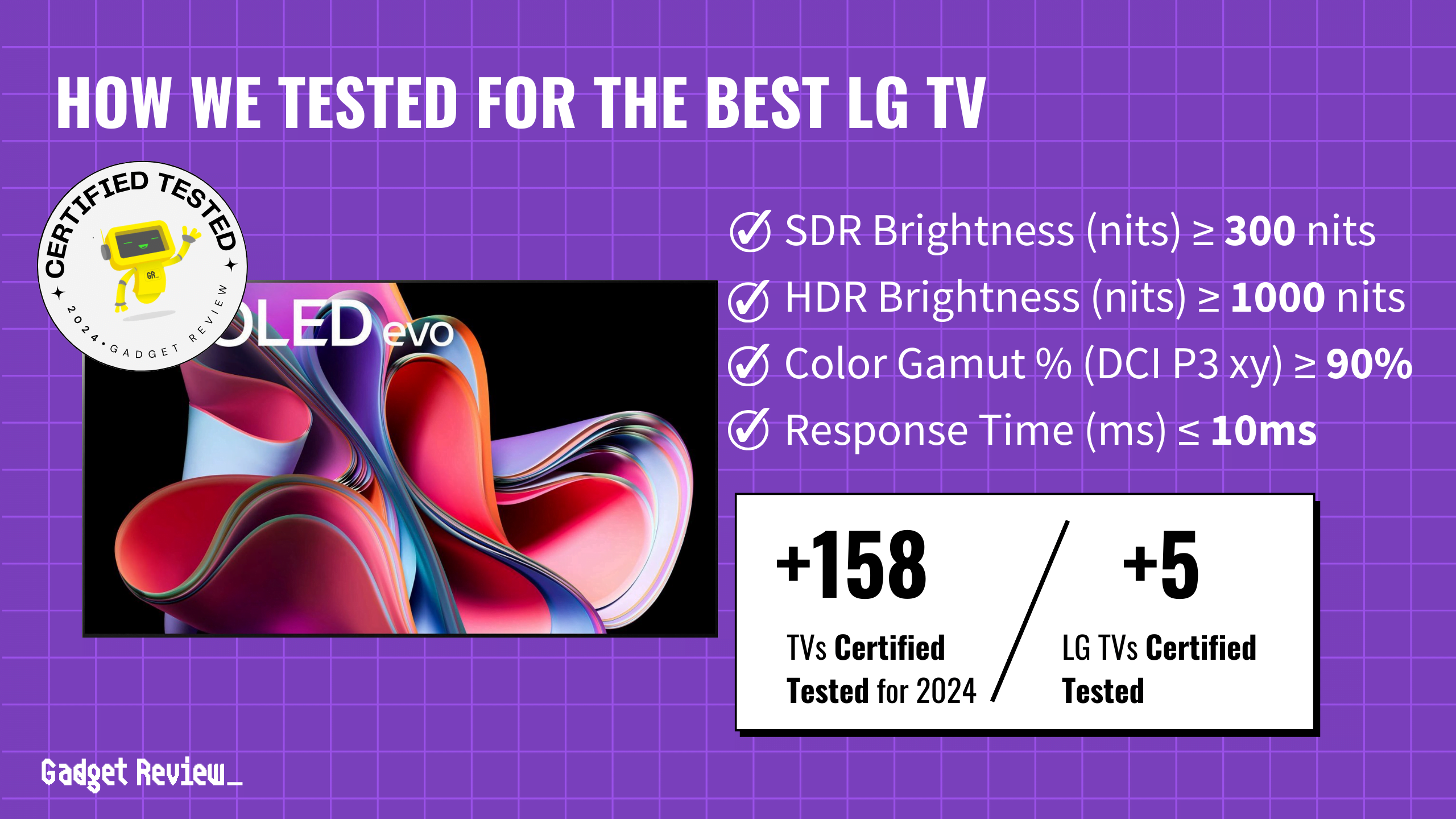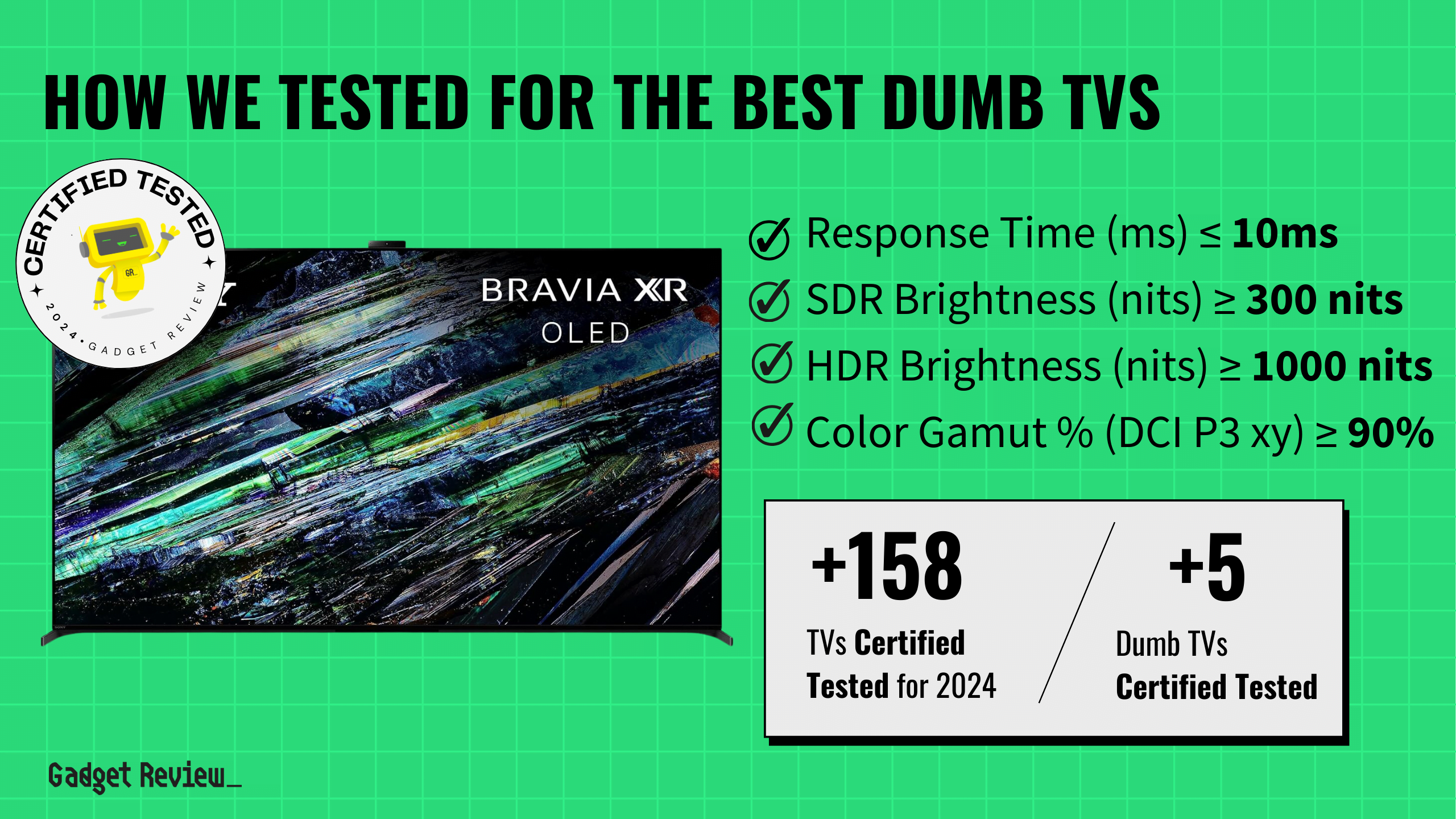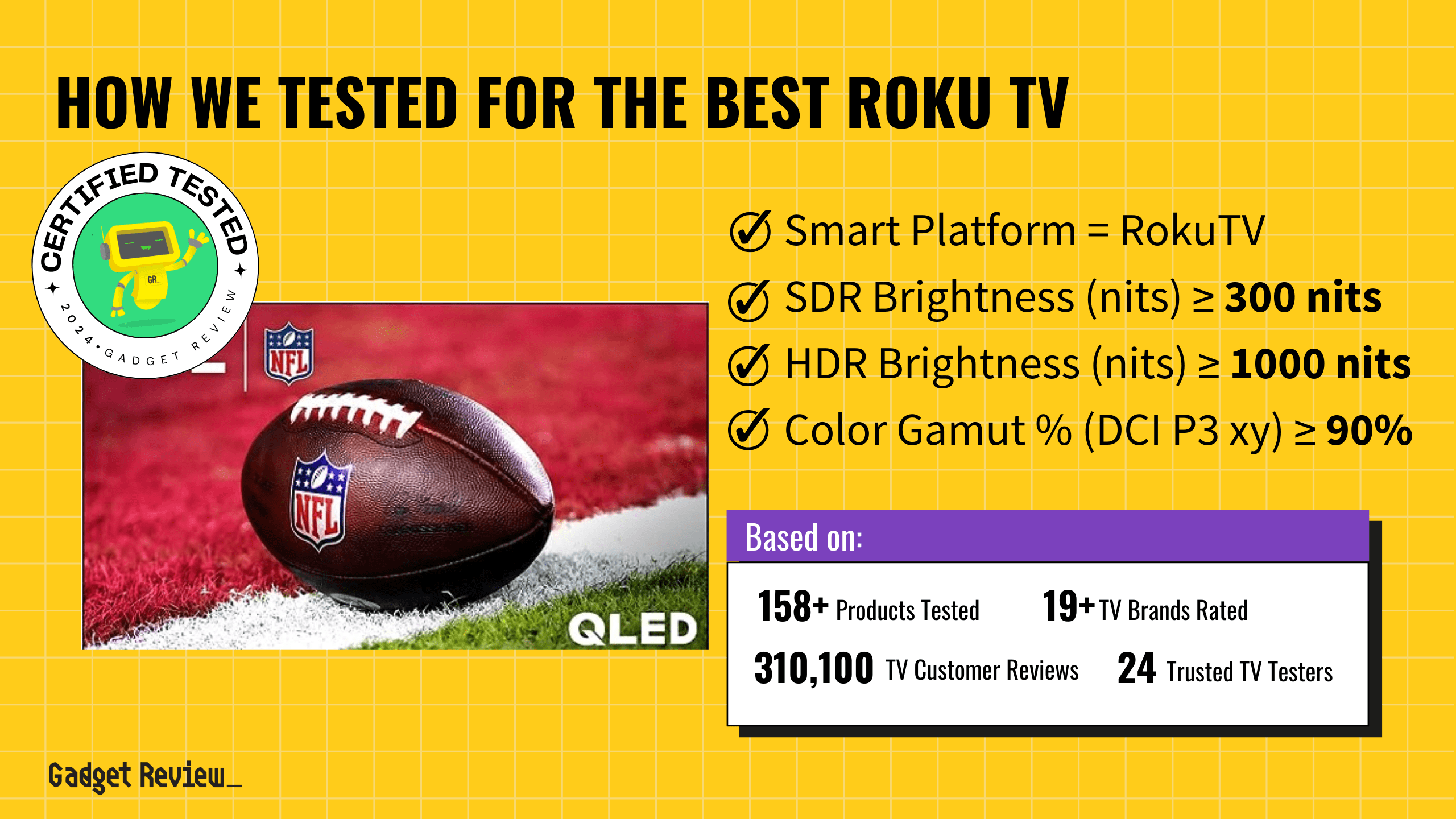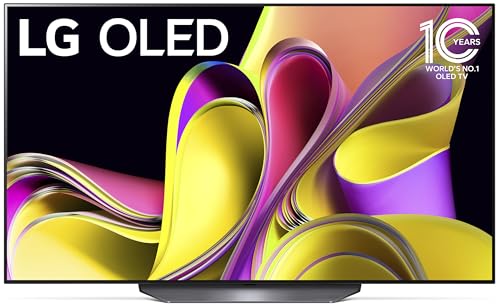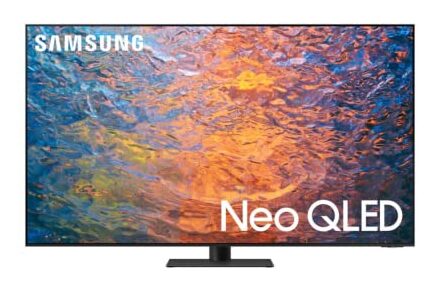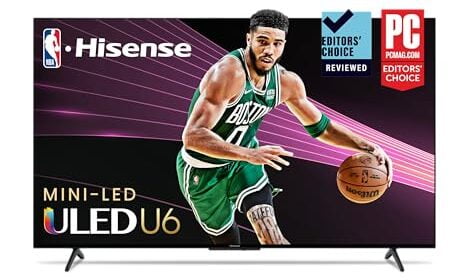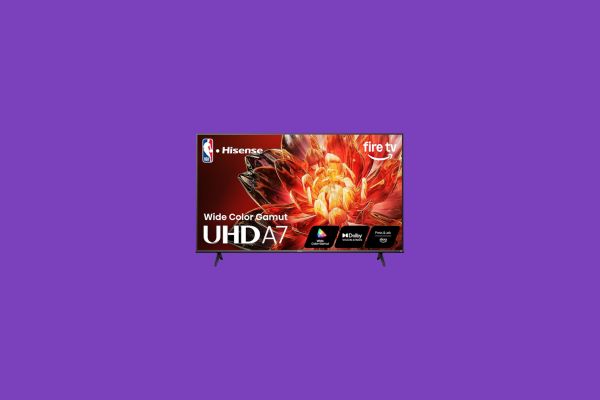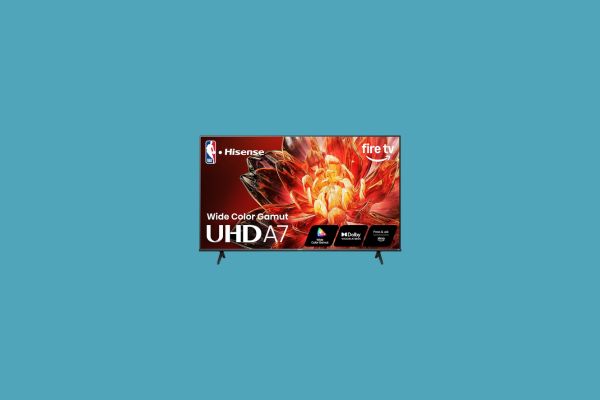Identifying the best TV brand involves more than just comparing prices; it’s about pinpointing the top-performing TVs from leading brands like Sony, TCL, Hisense, Samsung, LG, and Vizio. Our analysis, grounded in a robust Trust Rating system and rigorous testing data, highlights the standout model from each brand.
These selections aren’t necessarily the most budget-friendly options, but they represent the pinnacle of what each brand offers in terms of performance. Whether you prioritize picture quality, smart features, or overall value, our guide ensures you’re equipped with the information needed to choose the best TV that aligns with your specific viewing needs and preferences.
How Did We Rank the Best TV Brands?
To assess how high or low quality a TV actually is, one must evaluate specific testing criteria against reference industry standards. Using our thorough TV Testing Methodology, we determined there are 6 criteria below (3 required, 3 nice to have) that ensure your TV content looks as good as the creator intended it.
? Test Criteria
- SDR Brightness: Equal to or greater than 300 nits, ensuring a bright and clear display under any lighting conditions.
- HDR Brightness: 1000 nits or more, to reveal the finest details in high dynamic range content.
- Color Accuracy: At least 90% of the DCI P3 color gamut, providing rich and vibrant colors.
? “Nice To Haves”
- Contrast Ratio: 10,000:1 or higher, offering deep blacks and bright whites for an exceptional viewing experience.
- EOTF Accuracy: Delta E less than or equal to 0.018, for precise brightness and contrast across the board.
- Fast Response Time: 10ms or less, ensuring smooth transitions without motion blur.
We’ve redefined TV buying guides, setting us apart from any other site on the planet. Our unique approach combines in-house verification with a comprehensive dataset from over 200+ trusted sites, focusing on key testing metrics to rank the top-rated TV brands. Testing data and specs include SDR brightness of at least 300 nits, HDR brightness of 1000 nits and above, and color accuracy with a minimum of 90% DCI P3 color gamut. We aggregate and analyze this data from 158+ TVs, ensuring our recommendations meet your specific needs. For the Best TV brands, this means delivering unparalleled resolution, exceptional brightness and color fidelity for an immersive viewing experience. Our commitment to unbiased reviews is powered by our ‘True Score’ system, targeting low quality and fake reviews. Commissions fund this mission. No bias. No BS.
Latest Updates
- 03/06/2024: Completely and thoroughly overhauled the guide to include the best and latest TVs.
- 12/01/2023: Republished the list to include TVs based on our True Score system.
Top TV Brands For 2025
Prices accurate at the time of publishing

Best Overall

Runner Up

Best Value

Best Budget

Best Mid-Range

Premium Pick
Samsung S90C TV
The Samsung S90C delivers exceptional 4K clarity and brightness for various settings, with superior gaming and home cinema features, making it a high-end choice without the OLED price tag.
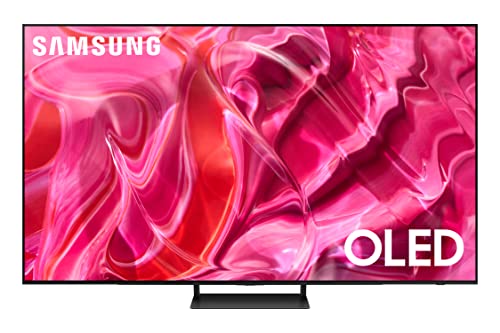
True Score
92948Experts
925kCustomers
Cosmic Wonder
 SAVE $500$1,499.99$999.99
SAVE $500$1,499.99$999.99Snapshot
Reasons to Buy
- Excellent picture quality
- The near-infinite contrast ratio for perfect blacks
- High peak brightness
- Exceptionally wide viewing angle
- Low input lag/Response time
- Sharp upscaling
Reasons to Avoid
- Aggressive Auto Brightness Limiter (ABL)
- No support for DTS or Dolby Vision
Specifications
Max Resolution 3840 x 2160 (4k) 
Backlight Type n/a Refresh Rate 120 Hz, 144 Hz Display Type OLED HDMI Inputs 4 
HDMI Type HDMI 2.1 HDR Format HDR10+, HLG 
HomeKit Compatible No 
Number of Audio Channels 2.1 
Panel Type OLED Screen size 55″, 65″, 75″, 83″ 
Smart Platform Tizen 
Speaker Output 40 Watts 
Sync Technology AMD FreeSync Premium 
VRR Yes All Specs
Test Results
SDR Brightness (nits) 373 HDR Brightness (nits) 1,058 Color Gamut % (DCI P3 xy) 99.975 Response Time (ms) 1.4 Contrast Ratio (x:1) 0 EOTF (600 nit delta) 0.0031 Color Gamut % (DCI P3 uv) 99.95 Color Gamut % (Rec 2020 xy) 86.37 Color Gamut % (Rec 2020 uv) 91.59 Color Gamut % (sRGB) 0 Color Gamut % (Rec 709) 0 Color Gamut % (BT.2020) 76 Color Gamut % (Adobe RGB) 0 Color Gamut % (BT.709) 0 Input Lag (ms) 8.5 Color Washout (Degrees) 70 Color Shift (Degrees) 70 Brightness Loss (Degrees) 70 Reflections (%) 1.2 Low-Freq Extension (Hz) 84.76 Freq Response StdDev @ 70db 2.8 Freq Response StdDev @ 80db 3.63 Weighted Total Harmonic Distortion @80db 0.133 Intermodulation Distortion @80db 2.47 EOTF (1000 nit delta) 0.0036 EOTF (4000 nit delta) 0.0024 All Tests
All Retailers
- $999.99$1,500Save $500
Availability
In StockFree Shipping
No - $1,297.95
Availability
In StockFree Shipping
No - $1,449.00$2,598Save $1,149
Availability
In StockFree Shipping
No
Our Verdict
The Samsung S90C stands out as a top pick for anyone in the market for a reliable 4K television. It shines with an SDR luminance of 373 nits and an HDR peak brightness of 1058 nits, ensuring clear visibility in both dimly lit and moderately illuminated environments. Its capability to remain vibrant in rooms with more light, especially when displaying HDR content, is a significant advantage. The screen’s low reflection rate at 1.2% means that glare is hardly a concern, although it’s advised against placing it in overly bright spaces.
If you’re a gamer, the S90C excels with its 120 Hz refresh rate and AMD Free Sync compatibility, boasting a swift response time of 1.4 ms and a minimal input delay of 8.5 ms. This makes it an ideal choice for reducing motion blur during fast action scenes, thus enhancing the experience for sports enthusiasts and ensuring that everyone can enjoy a clear view during large viewing parties, thanks to its wide viewing angle.
Home cinema aficionados will appreciate the robust HDR brightness coupled with a DCI P3 xy color coverage of 99.98% and an outstanding EOTF of 0.0031. Coupled with the virtually limitless contrast ratio enabled by OLED technology, the S90C promises a cinematic viewing experience with vibrant, true-to-life colors and deep blacks.
Overall, the Samsung S90C is engineered to offer superior gaming and sports viewing experiences, while also being fully equipped to handle a wide array of other multimedia content. Its performance across various settings, from movies and games to general content consumption in rooms with different lighting conditions, solidifies its status as a high-end option without the steep price often associated with OLED TVs.

Best Overall

Runner Up

Best Value

Best Budget

Best Mid-Range

Premium Pick
Sony A90K OLED TV
The compact Sony A90K offers OLED quality visuals and HDR experience in a smaller package, ideal for those prioritizing space and quality, though at a premium price.
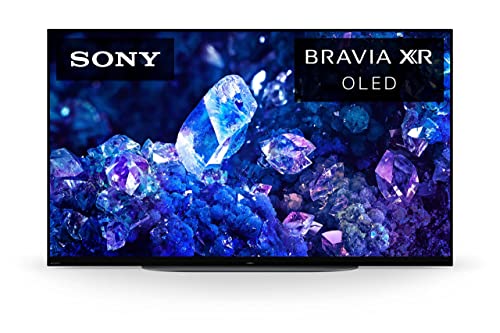
True Score
89867Experts
941kCustomers
Absolutely Fresh

Snapshot
Reasons to Buy
- Excellent picture quality
- High contrast ratio
- Low-tested response time and input lag
- Fast refresh rate and VRR support
- Wide viewing angles
Reasons to Avoid
- Limited HDR peak brightness
Specifications
Max Resolution 3840 x 2160 (4k) 
Backlight Type No Refresh Rate 120 Hz Display Type OLED HDMI Inputs 4 
HDMI Type HDMI 2.1 HDR Format Dolby Vision, HDR10, HLG 
HomeKit Compatible Yes 
Number of Audio Channels 7.1 
Panel Type RWBG Screen size 42″, 48″ 
Smart Platform Google TV 
Speaker Output 10W + 10W + 5W 
Sync Technology No 
VRR Yes All Specs
Test Results
SDR Brightness (nits) 288 HDR Brightness (nits) 593 Color Gamut % (DCI P3 xy) 99.375 Response Time (ms) 3 Contrast Ratio (x:1) 0 EOTF (600 nit delta) 0.004 Color Gamut % (DCI P3 uv) 99.67 Color Gamut % (Rec 2020 xy) 73.54 Color Gamut % (Rec 2020 uv) 78.83 Color Gamut % (sRGB) 0 Color Gamut % (Rec 709) 0 Color Gamut % (BT.2020) 71.2 Color Gamut % (Adobe RGB) 0 Color Gamut % (BT.709) 0 Input Lag (ms) 16.9 Color Washout (Degrees) 58 Color Shift (Degrees) 31 Brightness Loss (Degrees) 61 Reflections (%) 1.8 Low-Freq Extension (Hz) 126.99 Freq Response StdDev @ 70db 4.02 Freq Response StdDev @ 80db 4.58 Weighted Total Harmonic Distortion @80db 0.14 Intermodulation Distortion @80db 0.47 EOTF (1000 nit delta) 0.0041 EOTF (4000 nit delta) 0.0041 All Tests
All Retailers
Our Verdict
The Sony A90K OLED TV distinguishes itself with superior visual quality and quick responsiveness, boasting a DCI P3 xy color gamut coverage of 99.38% and an EOTF value of 0.0040. This allows for the display of rich, lifelike colors that rival those of the higher-priced A95L model. With an SDR luminance of 288.0 nits and an HDR peak luminance of 593 nits, it’s adept at delivering quality visuals in environments that are either dimly lit or have moderate lighting, though it may falter in brightly lit areas due to the overpowering natural light.
Notably, the A90K is more compact compared to other models, offering sizes that are considerably smaller than its counterparts, yet it still carries a premium price. Despite its smaller stature, it remains a top pick for sports enthusiasts thanks to its impressive 3.0 ms response time, which effectively minimizes motion blur during fast-moving scenes, ensuring that every detail is captured with clarity.
With an input latency of 16.9 ms, the A90K caters well to the casual gaming audience. While competitive gamers might find the slight delay too much for intense gameplay, casual players will likely find the response time fast enough for an enjoyable gaming experience.
The Sony A90K OLED TV is a versatile choice for a variety of applications, particularly appealing if you’re seeking a compact option. Though its smaller size doesn’t come with a smaller price tag, the investment gets you OLED contrast ratios and deep blacks, alongside Sony’s renowned color accuracy and HDR capabilities. It offers crisp visuals and a superior HDR viewing experience in a 48-inch package, making it an attractive option if you prioritize display quality and size efficiency over a larger screen.

Best Overall

Runner Up

Best Value

Best Budget

Best Mid-Range

Premium Pick
LG C3 OLED TV
The LG C3 combines excellent color accuracy and responsiveness with affordability, offering a top-tier viewing experience for both gamers and cinephiles in a versatile OLED TV.
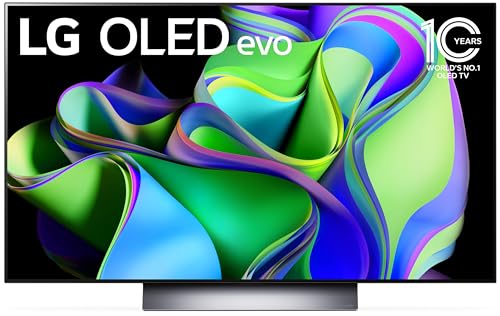
True Score
88879Experts
9312kCustomers
Absolutely Fresh
 SAVE $303$1,499.99$1,196.99
SAVE $303$1,499.99$1,196.99Snapshot
Reasons to Buy
- Excellent picture quality
- The near-infinite contrast ratio for perfect blacks
- Strong peak brightness
- High-performance motion handling
- Fast refresh rate
Reasons to Avoid
- Aggressive automatic brightness limiter
- Subpar sound quality
Specifications
Max Resolution 3840 x 2160 (4k) 
Backlight Type No Refresh Rate 120 Hz Display Type OLED HDMI Inputs 4 
HDMI Type HDMI 2.1 HDR Format Dolby Vision, HDR10, HLG 
HomeKit Compatible Yes 
LED Panel Type WOLED 
Number of Audio Channels 7.1.2 
Panel Type – Screen size 42″, 48″, 55″, 65″, 75″, 83″ 
Smart Platform webOS 
Speaker Output 20 Watts 
Sync Technology AMD FreeSync Premium, G-Sync 
VRR Yes All Specs
Test Results
SDR Brightness (nits) 383 HDR Brightness (nits) 795 Color Gamut % (DCI P3 xy) 98.98 Response Time (ms) 2.3 Contrast Ratio (x:1) 0 EOTF (600 nit delta) 0.0056 Color Gamut % (DCI P3 uv) 99.51 Color Gamut % (Rec 2020 xy) 73.28 Color Gamut % (Rec 2020 uv) 76.01 Color Gamut % (sRGB) 0 Color Gamut % (Rec 709) 0 Color Gamut % (BT.2020) 74.7 Color Gamut % (Adobe RGB) 0 Color Gamut % (BT.709) 0 Input Lag (ms) 9.6 Color Washout (Degrees) 63 Color Shift (Degrees) 34 Brightness Loss (Degrees) 70 Reflections (%) 1.1 Low-Freq Extension (Hz) 80 Freq Response StdDev @ 70db 1.14 Freq Response StdDev @ 80db 1.98 Weighted Total Harmonic Distortion @80db 0.085 Intermodulation Distortion @80db 4.49 EOTF (1000 nit delta) 0.0054 EOTF (4000 nit delta) 0.0051 All Tests
All Retailers
- $1,196.99$1,500Save $303
Availability
In StockFree Shipping
Yes - $1,196.99$2,500Save $1,303
Availability
In StockFree Shipping
No - $1,299.99$1,600Save $300
Availability
In StockFree Shipping
No - $1,596.99$2,497Save $900
Availability
In StockFree Shipping
Our Verdict
The LG C3 OLED TV delivers an impressive combination of performance and affordability. It distinguishes itself from LG’s premium offerings with its remarkable performance metrics and cost-effectiveness.
The DCI P3 xy color gamut coverage of 98.98% ensures that colors reproduced by the C3 are both vibrant and accurate, providing an excellent viewing experience. Its ability to display SDR content at 383 nits and HDR content at 795 nits allows it to perform well across a spectrum of ambient light settings, from dark to moderately lit spaces.
If you’re a cinephile, you’ll appreciate the C3’s EOTF value of 0.0056, which guarantees gamma is tracked with precision, faithfully presenting movies as the creators intended. Additionally, the TV’s swift response time of 2.3 ms and minimal input lag of 9.6 ms position it as a top choice for gamers seeking a display that’s both quick and reactive, as well as sports fans looking for game day viewing experience free of any kind of motion blur.
The LG C3 OLED TV excels in a broad range of viewing situations, from gaming to cinematic experiences, in both moderately lit and dim settings. Its focus on color fidelity, rapid response times, and low input lag make it a standout choice in the crowded OLED market, offering an attractive option for buyers wanting premium quality without the premium price tag.

Best Overall

Runner Up

Best Value

Best Budget

Best Mid-Range

Premium Pick
TCL QM8/QM850G QLED TV
With unparalleled brightness and solid color accuracy, the TCL QM8/QM850G excels in any lighting condition, offering a bright and dynamic viewing experience at a competitive price.
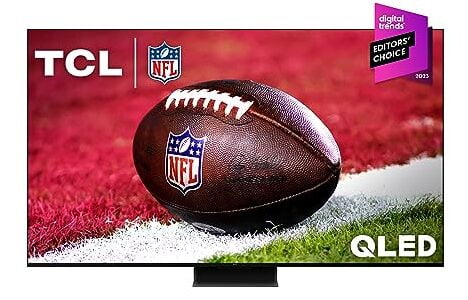
True Score
86847Experts
89476Customers
Absolutely Fresh
 SAVE $50$999.99$949.99
SAVE $50$999.99$949.99Snapshot
Reasons to Buy
- Outstanding picture quality
- Spectacular brightness and contrast ratio
- Rapid response time
- Super low input lag
Reasons to Avoid
- Disappointing viewing angles
Specifications
Max Resolution 3840 x 2160 (4k) 
Backlight Type Full-Array Refresh Rate 120 Hz 
Depth 11.7″ Display Type QLED HDMI Inputs (Total) 2 
HDMI Type HDMI 2.1 HDR Format Dolby Vision, HDR10, HDR10+, HLG 
Height 34.1″ High Dynamic Range (HDR) Yes 
Number of Audio Channels 3 
Panel Type LED Screen size 65″, 75″, 85″, 98″ 
Smart Platform Google TV 
Speaker Output 40 Watts 
Sync Technology AMD FreeSync Premium Pro 
VRR Yes 
Voice Assistant Google Assistant 
Weight 54.7 lbs 
Width 56.9″ 
Works With Amazon Alexa, Apple HomeKit, Google Assistant All Specs
Test Results
SDR Brightness (nits) 2,076 HDR Brightness (nits) 2,005 Color Gamut % (DCI P3 xy) 94.59 Response Time (ms) 8.9 Contrast Ratio (x:1) 114,057 EOTF (600 nit delta) 0.037 Color Gamut % (DCI P3 uv) 97.31 Color Gamut % (Rec 2020 xy) 75.81 Color Gamut % (Rec 2020 uv) 80.57 Color Gamut % (sRGB) 0 Color Gamut % (Rec 709) 0 Color Gamut % (BT.2020) 0 Color Gamut % (Adobe RGB) 0 Color Gamut % (BT.709) 0 Input Lag (ms) 14.3 Color Washout (Degrees) 24 Color Shift (Degrees) 31 Brightness Loss (Degrees) 32 Reflections (%) 1.8 Low-Freq Extension (Hz) 89.8 Freq Response StdDev @ 70db 4.74 Freq Response StdDev @ 80db 4.67 Weighted Total Harmonic Distortion @80db 0.128 Intermodulation Distortion @80db 8.67 EOTF (1000 nit delta) 0.0238 EOTF (4000 nit delta) 0.0271 All Tests
All Retailers
- $949.99$1,000Save $50
Availability
In StockFree Shipping
No - $998.00$1,136Save $138
Availability
In StockFree Shipping
Yes - $1,299.00
Availability
In StockFree Shipping
Yes
Our Verdict
The TCL QM8/QM850G stands out particularly for its unparalleled brightness.With an SDR brightness of 2076 nits and an HDR brightness of 2005 nits, it’s the go-to choice if you’re prioritizing a TV capable of delivering exceptional performance under any lighting scenario, from the lowest to the highest levels of ambient light. Its 1.8% reflectivity rate further ensures that the TCL QM8 preserves visual integrity and mitigates glare, offering an improved viewing experience in diverse settings.
Featuring a 120 Hz refresh rate, the TV guarantees fluid motion for all types of dynamic content, vital for engaging gaming sessions and watching fast-moving sports. With an input lag of 14.3 ms, it is on par with many other LED TVs, making it good for casual gaming, you’ll probably struggle if you’re a competitive gamer looking for the minimum delta possible.The QM8’s response time of 8.9 ms, on the other hand, is fantastic, making it an excellent option for sports enthusiasts who prefer watching in brightly lit areas.
The QM8 also performs well in color and contrast, with a DCI P3 xy color gamut of 94.59%, ensuring that colors are reproduced both vibrantly and accurately. However, its EOTF of 0.0370 suggests it may not track gamma as precisely as desired, which could be a drawback for home theater buffs who value the utmost in picture accuracy. Nonetheless, its high contrast ratio of 114,057:1 means that HDR content appears dynamic, with bright whites and deep blacks. If you’re looking for better color fidelity,, the Hisense U8K might be a more suitable choice.
If you want sheer brightness above everything else, the TCL QM8/QM850G QLED TV is an easy pick. It’s a powerful 4K television that combines peak brightness with commendable color precision and quick response times. Its performance makes it perfect for sports fans looking to place their TV in any lighting without worry. Whether in light or dark conditions, the QM8 confidently maintains quality, offering it at a price significantly lower than that of OLED options.

Best Overall

Runner Up

Best Value

Best Budget

Best Mid-Range

Premium Pick
Hisense U8K TV
The Hisense U8K shines in brightly lit environments with high brightness and color accuracy, making it a great value for home theater enthusiasts and casual gamers alike.
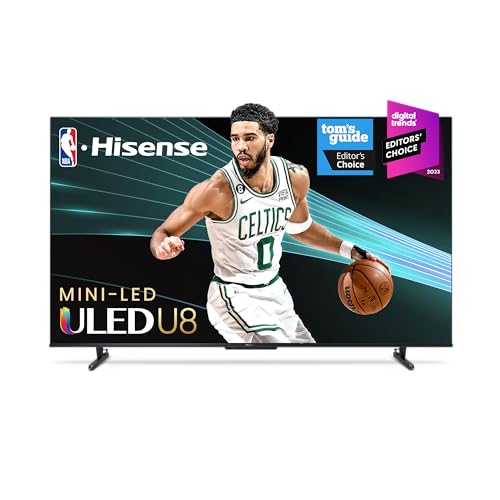
True Score
82816Experts
851kCustomers
Absolutely Fresh
 SAVE $150$999.99$849.99
SAVE $150$999.99$849.99Snapshot
Reasons to Buy
- Good picture quality
- Outstanding brightness and good contrast ratio
- Quick response time
- Great reflection handling
Reasons to Avoid
- Poor viewing angles
Specifications
Max Resolution 3840 x 2160 (4k) 
Backlight Type Full-Array Refresh Rate 144 Hz 
Depth 3″ Display Type LED HDMI Inputs (Total) 4 
HDMI Type HDMI 2.1 HDR Format Dolby Vision, HDR10, HDR10+, HLG 
Height 33.1″ High Dynamic Range (HDR) Yes 
Number of Audio Channels 2.1.2 
Panel Type VA Screen size 100″, 55″, 65″, 75″, 85″ 
Smart Platform Google TV 
Speaker Output 50 Watts 
Voice Assistant Google Assistant 
Weight 56.4″ lbs 
Width 57.2″ 
Works With Google Assistant All Specs
Test Results
SDR Brightness (nits) 1,549 HDR Brightness (nits) 1,792 Color Gamut % (DCI P3 xy) 97.44 Response Time (ms) 13.3 Contrast Ratio (x:1) 165,360 EOTF (600 nit delta) 0.0105 Color Gamut % (DCI P3 uv) 97.01 Color Gamut % (Rec 2020 xy) 76.18 Color Gamut % (Rec 2020 uv) 81.82 Color Gamut % (sRGB) 0 Color Gamut % (Rec 709) 0 Color Gamut % (BT.2020) 80 Color Gamut % (Adobe RGB) 0 Color Gamut % (BT.709) 0 Input Lag (ms) 14.2 Color Washout (Degrees) 23 Color Shift (Degrees) 23 Brightness Loss (Degrees) 35 Reflections (%) 1.8 Low-Freq Extension (Hz) 80 Freq Response StdDev @ 70db 2.06 Freq Response StdDev @ 80db 2.11 Weighted Total Harmonic Distortion @80db 0.1 Intermodulation Distortion @80db 0.71 EOTF (1000 nit delta) 0.0106 EOTF (4000 nit delta) 0.011 All Tests
All Retailers
- $849.99$1,000Save $150
Availability
In StockFree Shipping
No - $997.99
Availability
In StockFree Shipping
No - $1,300.00
Availability
In StockFree Shipping
No
Our Verdict
The Hisense U8K offers up great value and superior performance in well-lit environments. It boasts remarkable SDR and HDR brightness levels of 1549 nits and 1792 nits, respectively, ensuring that it produces excellent image quality even in spaces flooded with natural light. Coupled with a DCI P3 xy color gamut coverage of 97.44% and an EOTF value of 0.0105, this TV emerges as an ideal pick for home theater aficionados. Plus, the inclusion of Google TV OS enhances the U8K’s appeal by offering a vast selection of streaming services for effortless content consumption.
Its extensive color gamut and precise gamma accuracy guarantee that content is displayed as intended, making it suitable for home theaters that receive a lot of sunlight. This pairs great with the TV’s low reflectivity, at just 1.8% of total light reflected, which means the viewing experience remains free of annoying glare.
With an impressive contrast ratio of 165,360:1, the U8K not only excels in delivering dynamic home theater experiences but also stands out in gaming scenarios where having great black levels and high contrast makes it easier to find someone hiding in the dark. However, the TV’s input lag of 14.2 ms suggests it’s more suited to casual gaming than high-stakes competitive play. Additionally, its response time of 13.3 ms, while far from bad and fully capable of preventing motion blur in fast-action scenes and sports, is slower than the response times that OLED panels can offer.
The defining feature of the U8K is its ability to handle intense ambient light while still delivering outstanding EOTF, making it a prime candidate for those wishing to enjoy cinematic quality in their home theater without compromising due to bright conditions. Its price point and performance make it a fantastic competitor against even higher priced TVs, and its high brightness outdoes most OLEDs on the market. The U8K’s blend of features also makes it well-suited for enjoying sports, casual gaming, and seamless streaming, all with outstanding picture quality.

Our Approach to Testing The Best TV Brands

Evan Shepard/Gadget Review
We’ve redefined TV buying guides, setting us apart from any other site on the planet. Our unique approach uses a comprehensive dataset from trusted sites, focusing on key testing metrics like brightness (SDR and HDR), EOTF, response time, contrast ratio and color gamut.
We aggregate and analyze this data, ensuring our recommendations meet the specific needs. Specifically, when it comes to 4K TVs, this involves selecting models that deliver optimal image quality for content up to 4K resolution, including the ability to upscale lower-resolution content effectively. Discover our data-driven methodology for precise, reliable TV recommendations.
Which Criteria Matters for Testing Best TV Brands?
By focusing on these criteria (3 required, 3 nice to have), anyone can quickly and easily compare these TVs and how they’ll perform. This helps you make an informed decision and purchase a TV.
| CRITERIA | RANGE | REQUIRED | DEFINITION |
|---|---|---|---|
| SDR Brightness | 300+ nits | Yes | Assess the luminance of your display when operating in Standard Dynamic Range (SDR) mode. |
| HDR Brightness | 1000+ nits | Yes | Determine the luminance of your display in High Dynamic Range (HDR) mode. |
| Color Gamut (DCI P3 xy) | >= 90% | Yes | Evaluate the extent to which a TV can reproduce a specified spectrum of colors. |
| EOTF | 0.018 | No (nice to have) | Standard that governs how a display interprets and renders brightness and color. |
| Response Time | <=10ms | No (nice to have) | Time required for a pixel to transition from one color to another and then return to its original color. |
| Contrast Ratio | >= 10,000 | No (nice to have) | The ratio between the brightest white and darkest black that the screen can display. |
Our Trusted Data Sources
(Publication category Score is 80%+)
We looked at 210+ TV reviewers and while 24 are trustworthy (60%+ Trust Rating), we only use data from the testers that are “very trusted” which means a Trust Rating above 70%. The three we have listed below are our most trusted for TVs, along with our own in-house TV expert.
- Evan Shepard – Gadget Review
- Matthew Lopes – RTings, MuckRack
- Will Greenwald – PCMag, MuckRack, Twitter
- David Katzmaier – CNET, MuckRack, Twitter
Interested in a comprehensive analysis of our data sources? We’ve got you covered. Below, you’ll find a detailed list of every TV review website we’ve identified, organized by their respective Trust Ratings from highest to lowest. But we didn’t stop there. We’ve meticulously reviewed each publication and verified the data by checking whether the authors have bio links to MuckRack or LinkedIn. We’re committed to not only checking the facts but ensuring their veracity.
Best TV Brands Test Data & Results
1. SDR & HDR Brightness TV Test Results
In well-lit rooms, the brightness level of your TV, quantified in nits, is key to a great viewing experience. A TV that doesn’t meet the brightness requirement will struggle against natural and artificial light, resulting in a dim, lackluster image. Essentially, nits measure how well your TV can stand up to light interference, with higher values ensuring a sharper, more vivid display.
For standard viewing on the best TV brand, you should look for at least 300 nits to strike the right balance between clarity and color quality in standard dynamic range (SDR) content. For high dynamic range (HDR) content, which offers richer colors and greater contrast, a minimum of 1000 nits is ideal to truly appreciate the enhanced visuals. These brightness levels are recommended to ensure your top TV for bright rooms performs well in bright settings, allowing you to enjoy your shows and movies without any loss in detail or quality. Aim for these minimums: SDR Brightness >= 300 nits; HDR Brightness >= 1000 nits for the optimal experience. Keep in mind that display technologies can indicate whether a TV may have higher brightness than the other, like QLED vs LED TVs where QLED has significantly better brightness thanks to quantum dot technology layered on top of an LED backlight.
Discover the top TV brands, ranked from brightest to least.
Brightness
SDR: 300+ nits
HDR: 1000+ nits
Acceptable range of performance
Definition: Maximum brightness in a specified pattern size window. Most commonly measured in a 10% or 100% white window.
Units of Measurement: nits (alternatively cd/m²)
Tools to Measure: TV, luminance meter
Why It’s Important:
Brightness helps counter ambient light so that details and colors don’t wash out and get lost.
SDR Brightness (in nits, higher is better)
HDR Brightness (in nits, higher is better)
2. Color Gamut (DCI P3 xy) TV Test Results
Color Gamut
>= 90%
Acceptable range of performance
Definition: The TV’s capability to display a spectrum of colors.
Units of Measurement: % (color space coverage in percent)
Tools to Measure: Colorimeter
Why It’s Important:
Inaccurate colors compromise the authenticity of the content.
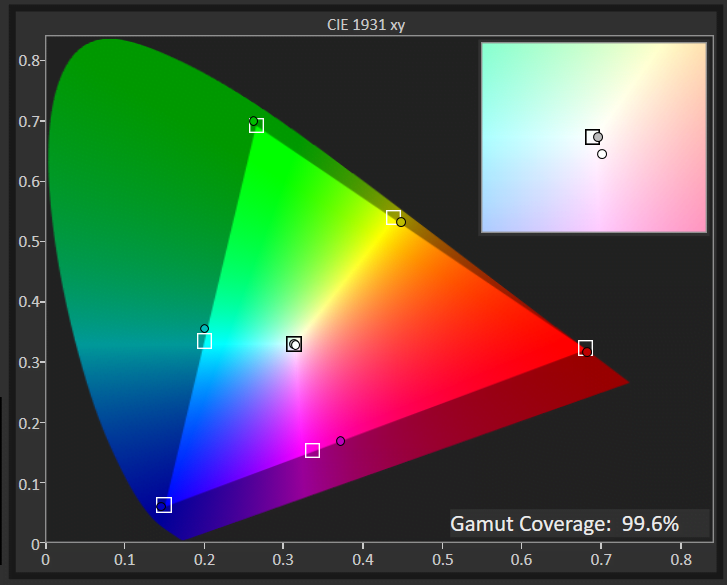
Color gamut defines the range of colors a TV brand can reproduce, directly affecting how vibrant and true-to-life the images look. A wide color gamut in a compact TV brings out richer, more vivid colors – from the lush greens of a garden to the bright colors of animated characters, enhancing your viewing experience to closely mimic real life.
This concept is technically measured against standards like the DCI P3 xy, a benchmark for high-quality visuals. A TV brand covering a higher percentage of this color space can display colors more accurately and vividly.
For those who prioritize vibrant and immersive visuals, aiming for a TV brand with a color gamut of 90% or higher on the DCI P3 xy scale is ideal. This ensures that the content you watch is as vibrant and lifelike as possible, bringing a big viewing experience to a smaller screen. Be aware that certain TV panel types indicate that a TV may have better color gamut. When comparing VA panel vs IPS TVs, IPS panels offer better color gamut and accuracy, making them ideal for tasks requiring precise colors, such as graphic design and photo editing.
Below are the top TV brands, ordered by color gamut, all exceeding our testing criteria.
DCI P3 XY Color Gamut (as a %; high is better)
3. EOTF Test Results
The Electro-Optical Transfer Function (EOTF) plays a critical role in ensuring the content on your TV looks exactly as the creator intended. This technical feature adjusts your screen’s brightness levels, ensuring every scene, from the darkest shadows to the brightest highlights, is displayed with true-to-life accuracy.
In rooms flooded with light, a TV that nails EOTF calibration shines by preserving the intended contrast and detail in the picture despite the challenging conditions. It balances the brightness so that images remain vibrant and full of detail, unaffected by the glare of ambient light.
A TV that excels in managing EOTF offers an immersive and authentic viewing experience. It brings creators’ visions to life, accurately rendering every scene with the proper light and dark levels, no matter the lighting in your room. This means you get a consistent, realistic picture that captures the full spectrum of colors and contrasts, from the subtlest hues to the most intense explosions. Below is all the TVs on this guide sorted from best to worst in EOTF.
Below are all the TV brands on our list, ordered by EOTF.
EOTF
< 0.018 (600 nit Δ)
Acceptable range of performance
Definition: How your TV interprets and renders the luminance data from content and translates it to be represented on screen. If EOTF/Gamma tracking is too low or too high, it will result in an over-brightened or over-darkened image from reference.
Units of Measurement: this test measures for the delta from the standard
Tools to Measure: Luminance colorimeter
Why It’s Important:
EOTF ensures that the game is displayed (color and HDR brightness) as the creator intended it
EOTF (source: rtings.com – 0 = no data exists; lower is better)
4. Response Time TV Test Results
Response Time
1ms-10ms
Acceptable range of performance
Definition: Speed at which a pixel transitions from one color to another
Units of Measurement: milliseconds (ms)
Tools to Measure: Screen, camera, test software
Why It’s Important:
A faster response time means less blur and thus more accuracy
A slow response time on a TV brand during fast-paced scenes is like trying to watch a thrilling movie with a foggy lens. Imagine settling in for an action-packed sequence, only to have the swift movements turn into a blur, robbing you of the crisp, clear detail you crave. This isn’t just a minor annoyance; it’s a major detriment to your viewing experience, leaving you with a picture marred by motion blur and visual artifacts.
So, what exactly is response time? It measures how quickly a pixel on your TV can change from one color to another. In the context of watching fast-moving content or enjoying dynamic scenes on a TV brand, a low response time is crucial. A response time of 15 ms or lower is good, but if you plan on gaming on this set, aim for a response time of 10 ms or lower. At these levels, your small TV ensures smooth transitions and sharp visuals, making every scene come to life without any distracting blurs or delays.
Below are the top TV brands, ordered by response time.
Response Time (in milliseconds; lower is better)
5. Contrast Ratio Test Results
For small TV enthusiasts, a solid contrast ratio is crucial for enjoying your favorite TV shows or movies, especially in darker settings. This feature directly impacts how lifelike and dynamic the picture appears on your screen, ensuring that dark scenes are displayed with clear, crisp blacks instead of murky grays and bright scenes retain their detail without appearing washed out.
Put simply, the contrast ratio is all about the range of luminance a TV can produce, from the deepest blacks to the brightest whites. It’s what brings depth to the image, enhancing the realism of every scene. Watching a movie in the dark, for example, the difference between a TV with a poor contrast ratio and one with a high ratio is stark: the former struggles, blending shadows into a flat gray, while the latter delivers true black, making night scenes more immersive and detailed. For seniors who want clarity and ease of viewing out of the best TV for the elderly, opt for a TV with a high contrast ratio. It ensures that all content, from movies to daily news, is displayed with maximum detail and minimal eye strain.
Ideally, a contrast ratio of 10,000:1 is what you should aim for in a TV brand. This level of luminance variance ensures that you’re getting a picture quality that can handle the nuances of lighting in any scene, providing a viewing experience that’s both rich and engaging. Note: OLED TVs have infinite contrast ratio, indicated by “0.”
Below are the top TV brands, ordered by contrast ratio, all exceeding our testing criteria.
Contrast Ratio
>=10,000:1
Acceptable range of performance
Definition: Difference between the darkest black and the brightest white a screen can display.
Units of Measurement: cd/m2
Tools to Measure: Luminance meter
Why It’s Important:
A higher contrast ratio delivers deeper blacks, enhancing content definition, especially in darker rooms.
Contrast Ratio (higher is better)
Best TV Brands: Mistakes To Avoid
- Ignoring the Features That Matter: Consumers sometimes get swayed by flashy features that they might not necessarily need or use. For instance, buying a TV with 8K resolution when the content available is primarily in HD or 4K, or purchasing a smart TV with numerous apps and functionalities when they primarily use external devices for streaming. Keep in mind where you’ll be using the TV as well.
- Overlooking Display Quality: Some consumers focus solely on the brand, the size like the best 75-inch TV, or the price tag without paying enough attention to the display quality. Factors such as contrast ratio, color accuracy, and viewing angles are crucial for a satisfying viewing experience. Ignoring these aspects can result in disappointment with the purchased TV’s performance.
- Not Considering Room Size and Viewing Distance: A common mistake is not considering the size of the room where the TV will be placed and the typical viewing distance. Buying a TV that’s too large or too small for the space can lead to discomfort or suboptimal viewing experiences. Though the best 80-inch TV may be tempting, make sure you have enough space in the room to comfortably use it, otherwise the top-rated 50-inch TVs can be the more optimal fit for your space. Similarly, failing to account for the viewing angle can result in poor picture quality.
- Neglecting Future-Proofing: With rapid advancements in technology, it’s essential to consider future-proofing when buying a TV from the best store possible. This involves looking at factors such as HDMI ports, software updates, and compatibility with emerging technologies like HDR formats or gaming consoles. Choosing a TV without considering these aspects might lead to obsolescence sooner than expected. Consider investing in leading 8K TVs for a future-proof setup, but understand the differences between 4K vs 8K to ensure they suit your needs.
The Best TV Brands Tests Compared
Product |
True Score
|
SDR Brightness
|
HDR Barightness
|
Color Gamut
|
EOTF
|
Response Time
|
Contrast Ratio
| |
|---|---|---|---|---|---|---|---|---|
| 92 |
|
|
|
|
|
| |
| 89 |
|
|
|
|
|
| $1,298.00 $1,300 $2 |
| 88 |
|
|
|
|
|
| $799.00 $1,300 $501 |
| 86 |
|
|
|
|
|
| |
| 82 |
|
|
|
|
|
|

